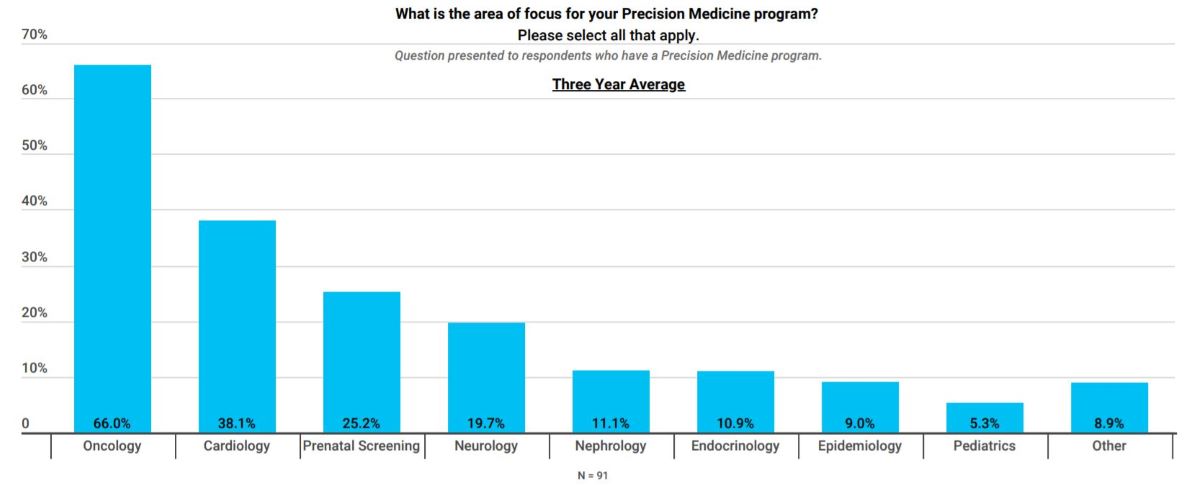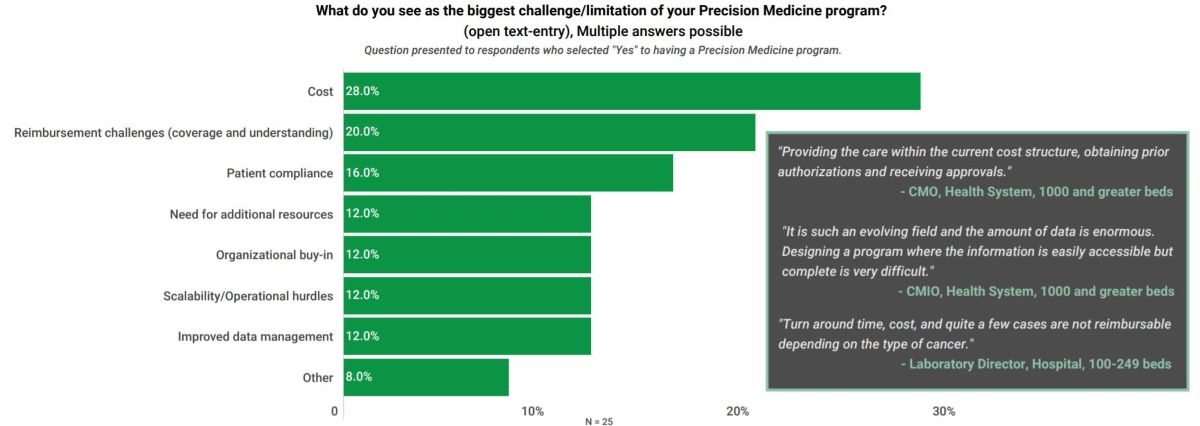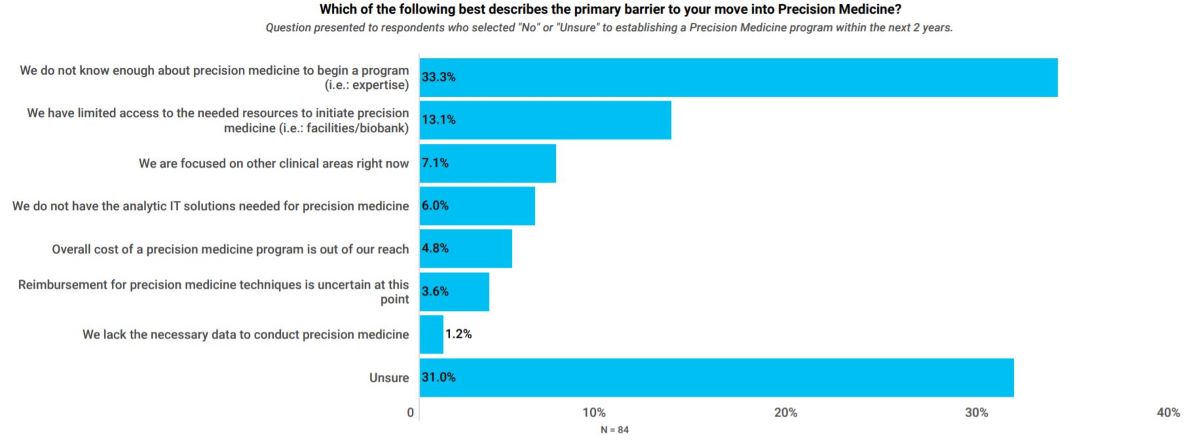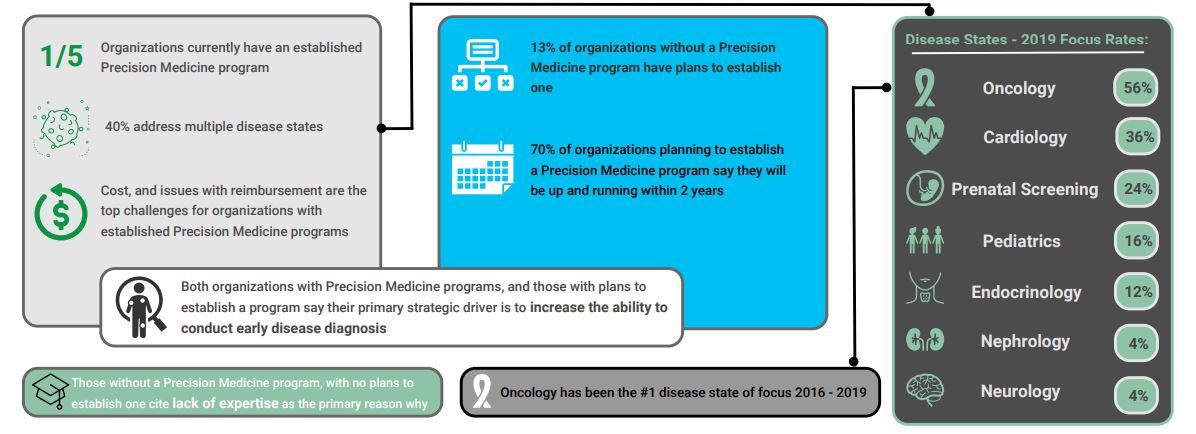The National Institute of Health (NIH) defines precision medicine as an approach to disease prevention and treatment based upon individual differences in environment, genes, and lifestyle.
Precision medicine programs in U.S.-based acute care organizations are projected to more-than-double over the next ten years. With the government’s unveiling of the Precision Medicine Initiative in 2015—which resulted in a $215 million dollar investment in the NIH’s 2016 budget—precision medicine is now seen as a healthcare approach for both the future and the present, particularly with the explosion of personalized care delivery. Technology, analytics, pharmaceuticals, imaging, genomics, and the research and development industry as a whole are just some of the many verticals that could see immense growth from their contributions to precision medicine.
In anticipation of this trend, Definitive Healthcare surveyed healthcare leaders at U.S.-based acute care organizations in its first-ever “Precision Medicine Study.” The goal of this study—conducted from September to October 2019—was to establish the rate at which precision medicine programs are established, what their strategic care approaches might be, and the greatest challenges that precision medicine programs might face. Here are the main findings:
Slow growth in precision medicine
For a market expected to see exponential growth over the next ten years, Definitive Healthcare’s study actually indicates a limited existing establishment of precision medicine programs across the U.S.—with only one-fifth of healthcare organizations currently implementing a program. The study also shows minimal growth over the next few years, landing at just 13.4 percent.
However, the study also reveals that smaller organizations have also started to enter the fold, which could indicate future growth in the precision market arena.
Largest areas of focus in precision medicine studies

Fig 1: Definitive Healthcare’s Precision Medicine Study (2019), disease states
With 66 percent of the focus in existing precision medicine programs, oncology is the disease state with the greatest investment of experimental resources. There are, however, a number of other disease area leaders as well. Respondents also named cardiology, prenatal screenings, and neurology as areas of interest for precision medicine programs—with 38.1 percent, 25.2 percent, and 19.7 percent engagement in existing programs, respectively.
Precision Medicine Program Adoption Challenges & Barriers
Organizations offer a variety of different responses regarding their greatest challenges in establishing or maintaining a precision medicine program. Below are two of the most commonly reported limitations:
- Cost: Twenty-eight percent of respondents agree that cost is the most common challenge they face—a common issue given the high expenses associated with genomic sequencing, and the increased potential for higher spending with companion testing.
- Reimbursement challenges: In close second, 20 percent of respondents named reimbursement as another key obstacle. Payers might be naturally more inclined to challenge or deny expensive treatment costs—making it significantly more difficult to obtain (and understand) coverage options.
Respondents noted several other areas of contention, including: patient compliance, the need for additional resources, organizational buy-in, scalability and/or operational hurdles, and improvements to internal data management systems.
Challenges of precision medicine programs

Fig 2: Definitive Healthcare Precision Medicine Study (2019), challenges
Further, organizations without a Precision Medicine program and with no plans to establish a program in the near future cite a lack of expertise as the primary obstacle that they face in entering the precision medicine space.
Due to the complexity of the clinical methods involved—which include structuring the data, amassing specialized disease knowledge, and organizing the support staff necessary to launch a successful program—many organizations may require guidance before entering this area of healthcare.
And, with 33.3% of respondents citing a “lack of expertise” as a primary barrier in entering the space, there is real opportunity for executives and leaders within existing precision medicine programs to help guide other organizations through the process.
Barriers to implementing precision medicine programs

Fig 3: Definitive Healthcare Precision Medicine Study (2019), barriers
2019 Precision Medicine Study round-up

Fig 4: An overview of the Definitive Healthcare Precision Medicine Study (2019)
Although the 2019 Precision Medicine Study shows limited establishment of precision medicine programs, the number of disease state treatment areas has already increased markedly in just the past few years. Most notably, we have also seen a number of new, smaller organizations enter the space—a key growth indicator in these early stages of precision medicine. With treatment options likely to become more affordable as specialized technologies become more advanced, the market seems ripe to foster significant development in the coming years.
Further insight into precision medicine and the strategic approach of existing programs can be uncovered in Definitive Healthcare’s 2019 Precision Medicine Study.
Learn more
Definitive Healthcare’s platform is updated daily, providing insight into 7,900 hospitals and 900 IDNs throughout the U.S., including contact information for executives and leadership, affiliations, detailed hospital financial, clinical, and quality metrics, open requests for proposals (RFPs and CONs), technology implementations, and real-time coverage of merger and acquisition activities, software implementations, and more.
With Definitive Healthcare’s platform, users can:
- Review payor mix: See what percentage of hospital patients are covered by Medicare, Medicaid, or a commercial payor such as Blue Cross Blue Shield or UnitedHealthcare
- Segment the hospital market: Target hospitals by type (children’s, psychiatric, short-term acute care, etc.) number of staffed beds, region, state, CBSA population, geographic classification, and other filters.
- Analyze inpatient and outpatient claims: Review estimates of total payments for specific inpatient and outpatient procedures. Analyze claims by DRG codes, diagnoses, procedures, costs, readmissions, or revenue centers.
- Submit project proposals: Receive daily alerts of hospital RFPs for new construction, technology implementations, facility closings, and other products and services.
Contact Us to read the in-depth study or request a free trial





